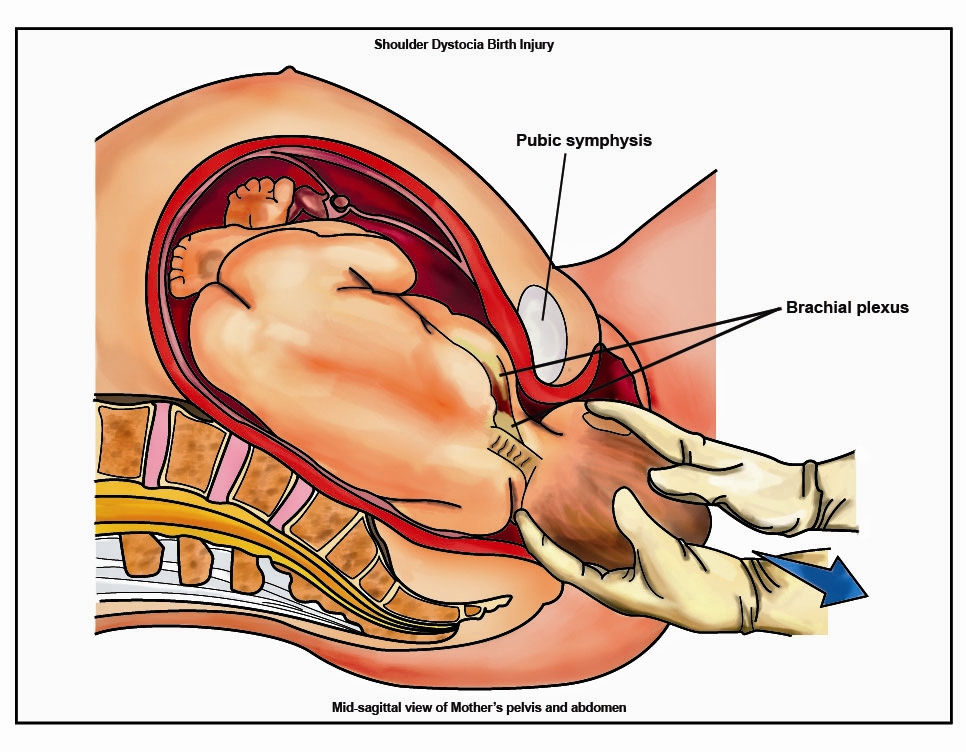
What is shoulder dystocia?
This is a medical term that is used when the baby’s head has been born but the shoulder becomes stuck behind the mother’s pelvic bone (pubic symphysis) making it difficult for the baby’s body to be delivered. When this happens, the oxygen supply to the baby is diminished as the baby could not breathe when its chest and the umbilical cord remains compressed in the mother’s pelvis.
Is it common?
Shoulder dystocia occurs in about one in 200 (0.5%) of births.
What happens if the baby has shoulder dystocia at delivery?
This is an emergency. The doctors or nurses will have to act quickly. An emergency alarm will be activated to get more doctors and nurses to help. The doctor or nurse will then do several things:
- Ask the mother to stop pushing.
- Place the woman on her back and push both of her legs towards her abdomen. This is known as McRobert’s manouevre which increases the birth canal opening to make it easier to deliver the baby’s shoulders.
- Press on the mother’s abdomen just above her pelvic bone. This is known as suprapubic pressurewhich could help dislodge the baby’s shoulder from behind the pubic bone.
- Episiotomy which is a cut on the perineum may be needed to enlarge the vaginal opening.
- Other manoeuvres will also be attempted to rotate the baby’s shoulders within the birth canal to free the shoulders so that the baby’s body can be delivered. This will only be done if the above mentioned manouevres fail to dislodge the baby’s shoulders.
This situation could be very frightening for the patient and her partner but everyone involved needs to stay calm. It is best for the patient to listen and follow the doctor’s instructions to help deliver the baby in shortest time as possible.
Could shoulder dystocia be predicted before delivery?
Unfortunately, most shoulder dystocia could not be predicted accurately and hence be prevented. However, all doctors and nurses who attend birth are familiar with the above manoeuvres which are practiced regularly in most maternity units.
What are the risk factors associated with shoulder dystocia?
- Large babies (especially more than 4.5kg)
- Diabetes in pregnancy
- Previous shoulder dystocia
- Induction of labour
- Slow progress in labour
It is important to note that ultrasound scanning is not an accurate predictor of birth weight towards the end of pregnancy especially in larger babies. In addition, about half of all the babies who have shoulder dystocia weigh less than 4 kg.
What are the complications that could occur with shoulder dystocia?
To the baby:
- Injury the baby’s nerves in the neck (i.e brachial plexus). This occurs in about 10% of cases and may cause loss of movement to the baby’s arm. In most cases, this is temporary and muscle movement will return within hours or days. 1 in 100 babies will experience permanent damage.
- Other injuries could occur including fractures of the arm or shoulder which is most cases heal without any problems.
- However, in some situation, a baby could suffer from brain damage or even die due to lack of oxygen during delivery.
To the mother:
- Vaginal tears
- Heavy bleeding (post partum haemorrhage)
- Emotional trauma
What should I do if in my previous pregnancy I had shoulder dystocia?
This should be discussed with your obstetrician on what would be the best option for you in the next pregnancy. An elective caesarean section may be offered.
RECOMMENDED BOOKS:
[easyazon-image align=”none” asin=”0761148574″ locale=”us” height=”160″ src=”http://ecx.images-amazon.com/images/I/61ehkftyEjL._SL160_.jpg” width=”109″] [easyazon-image align=”none” asin=”143917511X” locale=”us” height=”160″ src=”http://ecx.images-amazon.com/images/I/5199yh-%2BlzL._SL160_.jpg” width=”124″] [easyazon-image align=”none” asin=”1440528519″ locale=”us” height=”160″ src=”http://ecx.images-amazon.com/images/I/51K8MM96Y7L._SL160_.jpg” width=”138″] [easyazon-image align=”none” asin=”B00514J45C” locale=”us” height=”160″ src=”http://ecx.images-amazon.com/images/I/51fZi3ghY4L._SL160_.jpg” width=”120″] [easyazon-image align=”none” asin=”1554073804″ locale=”us” height=”160″ src=”http://ecx.images-amazon.com/images/I/5143oayY1iL._SL160_.jpg” width=”123″]
REFERENCE:
A difficult birth: What is shoulder dystocia? Royal College of Obstetricians and Gynaecologists, Nov 2007.
Filed under Labour Complications | No Comments








